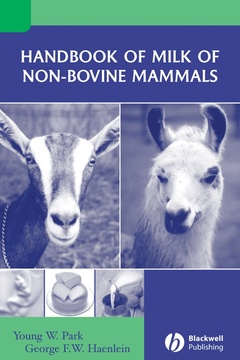Description
Handbook of milk of non-bovine mammals
Author: PARK Young W.
Language: English
Subjects for Handbook of milk of non-bovine mammals:
Approximative price 205.52 €
Subject to availability at the publisher.
Add to cart472 p. · 18x25 cm · Hardback
Description
/li>Contents
/li>
1. Introduction Overview of Milks of Secondary Species.
Part One: Goat Milk and Sheep Milk.
2. Production of goat milk (US and world).
3. Chemistry and nutrition of goat milk.
4. Goat milk products (Manufacture, technology, types of products, composition).
5. Sensory characteristics of goat milk and other minor species milk products.
6. Therapeutic and hypo allergenic values of goat milk and implication of food allergy.
7. Sheep Milk: Production and utilization Part Two: Milks of Other Minor Species.
8. Buffalo Milk: Production and utilization.
9. Mare Milk: Production and utilization.
10. Camel Milk: Production and utilization.
11. Yak Milk: Production and utilization.
12. Deer (Reindeer) Milk: Production and utilization.
13. Sow Milk: Production and utilization.
14. Llama Milk: Production and utilization.
15. Production and Utilization of Milks of Other Minor Species.
Part Three: Human Milk.
16. Human Milk: Production and utilization Index



